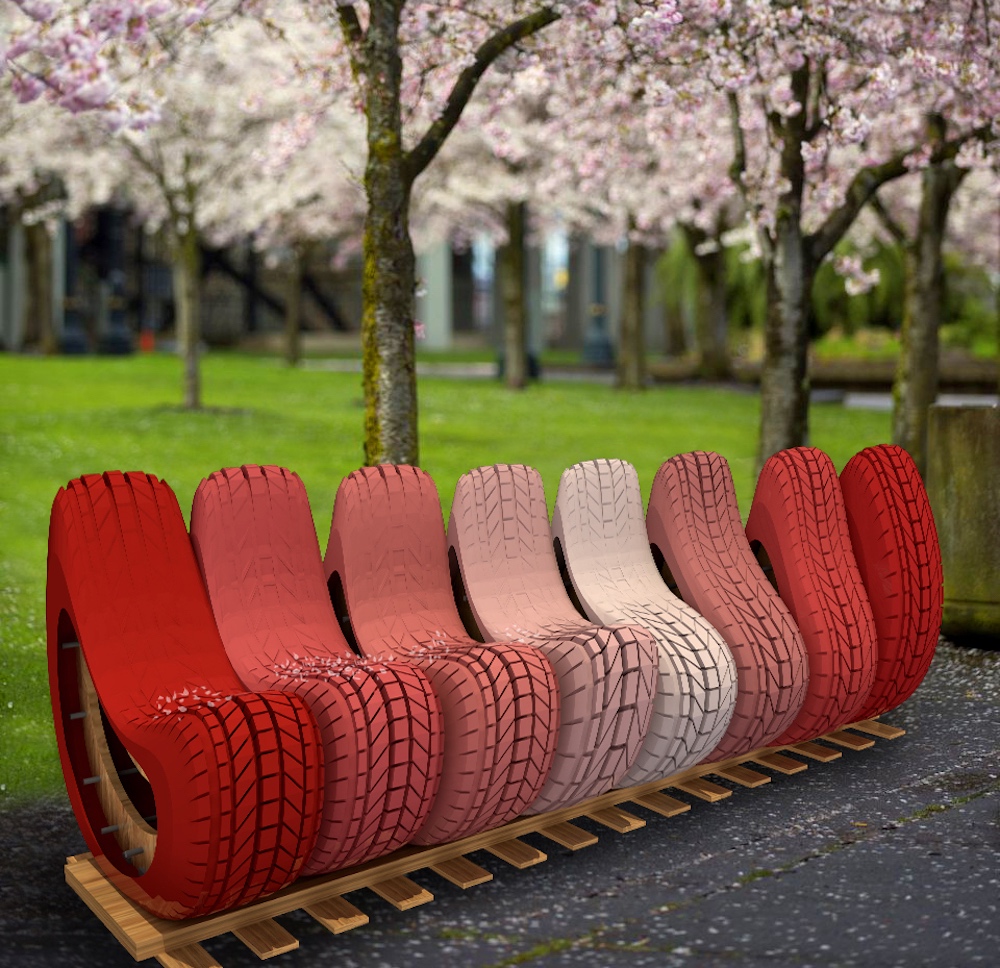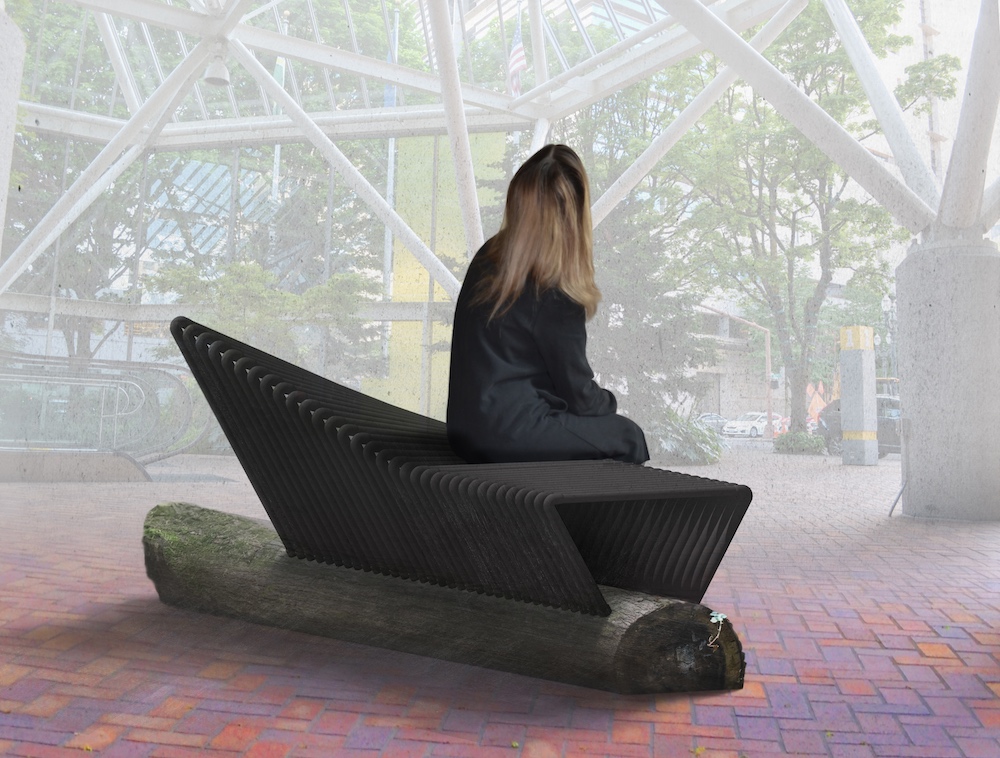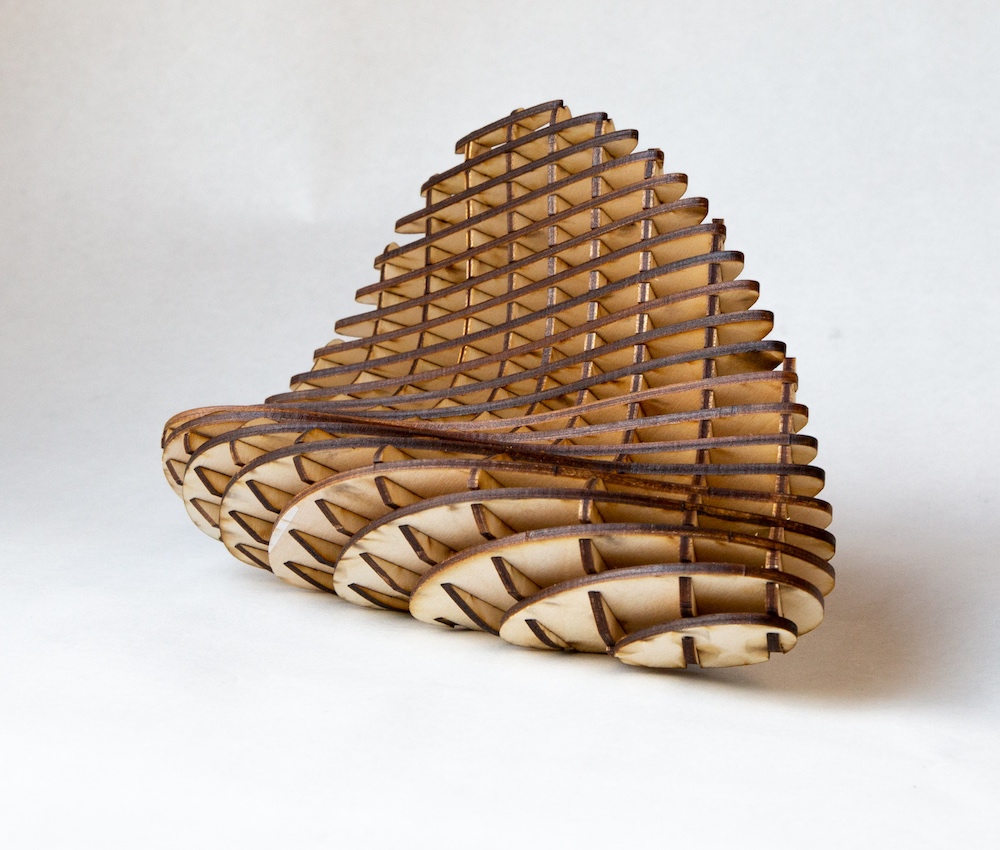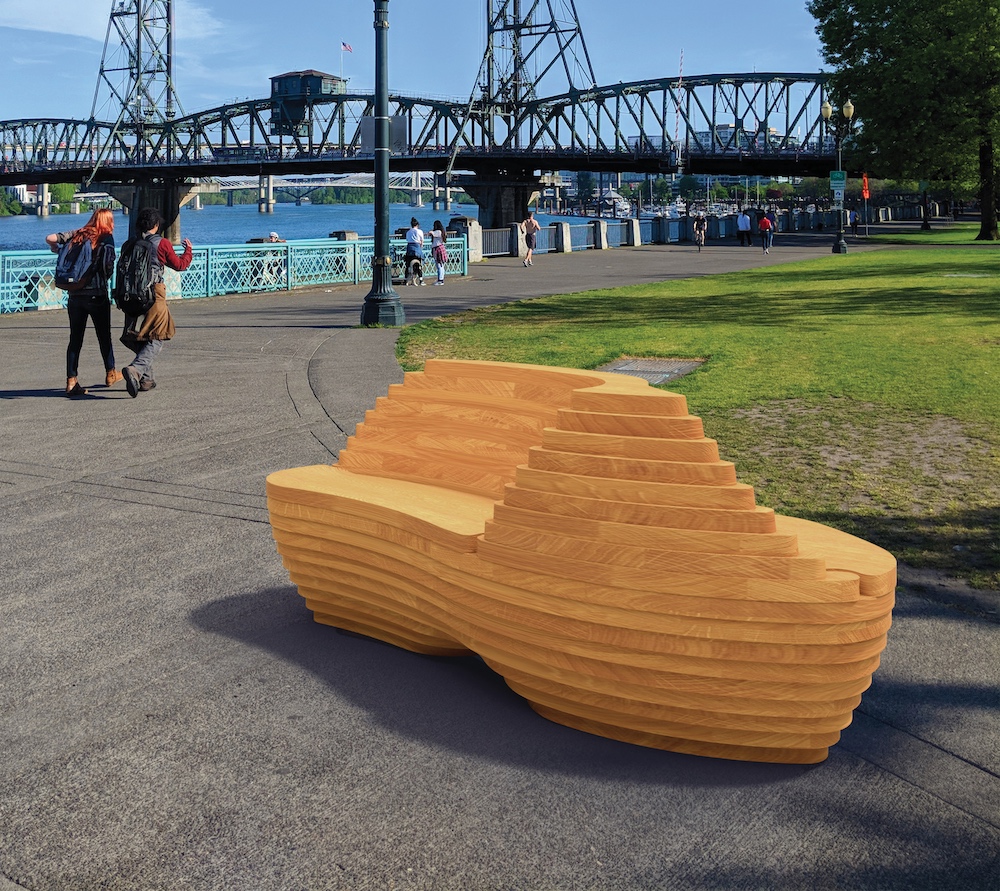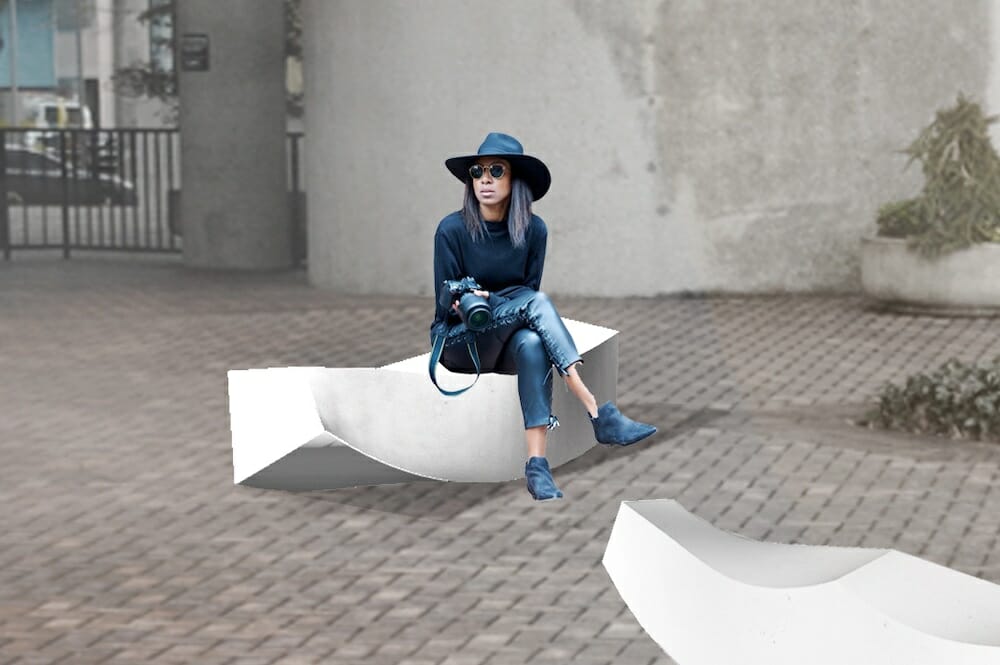Street Seats
Urban Placemaking in Portland
Portland is a vibrant city, and with vibrancy comes change. In the last few years, Portland’s quirky atmosphere and proximity to the natural environment has made it a hotspot for tech firms, real estate developers, and nature lovers alike, leading to increased development, particularly in the city-center.

Fractal Rock, Holst Architecture’s bench design for Street Seats, is on-view with 14 other public seating installations through February 2019 at World Trade Center Portland
By Erica Rife & Monica Andrews
The result: the city now finds itself fighting to preserve the ethos that made it so popular in the first place. World Trade Center Portland, a three-building office complex home to Portland General Electric (PGE) and the Oregon Trade and Marketing Center, is on the forefront of adapting to a changing city. The site is nestled into the historic downtown district, defied by its brick sidewalks, iconic gold water fountains, and ample foliage. They employed Portland’s own ZGF Architects to create a structure that would encourage foot- traffic on and around their outdoor plaza. They created a “skybridge,” a series of glass-plated enclosures connecting the Center’s three towers and allowing visitors to enjoy views of the surrounding landscape: Tom McCall Waterfront Park, Salmon Street Springs, the eastern skyline, and Mt. Hood. The building complex is now considered a landmark and hosts several city-wide celebrations.
The next challenge for the complex was placemaking at street level — connecting the site with the city and the riverfront. At the CoDesign Collaborative we’re always looking for projects where we can demonstrate the transformational power of design to improve the livability of our communities. The partnership between CoDesign Collaborative Portland, World Trade Center Portland, and PGE was a natural one.
In 2013 we developed a unique program to activate the area around Boston’s Fort Point Channel with new public seating designed by creative people around the world. The result was Street Seats, 18 unique public benches situated around the waterway for people to gather, connect, and experience Boston’s harborwalk. We thought we could apply this same approach to World Trade Center Portland to bring the public into this landmark space while connecting the site with the riverfront and the rest of downtown Portland.
“Street Seats is a testament to the power of collaborative design and its ability to engage and inspire community with something as seemingly simple as a place to sit,” said Matt Edlen, CoDesign Collaborative Board member and Director of Midwest/East at Gerding Edlen. “Local, national, and international designers transformed Boston’s Fort Point Channel neighborhood in 2013, and will bring new, innovative designs to Portland in 2018.”
“With the urban landscape in Portland changing so quickly, we want the World Trade Center to be a place where employees, residents and visitors all feel welcome and delighted,” said Cindy Laurila, corporate real estate manager at PGE. “The Street Seats competition gives us an opportunity to transform our area to offer more opportunities for creative expression and human connection.”
To garner ideas from the around the world we launched a Call for Entries in January 2018 to “Reimagine the Public Bench.” Participants had to use environmentally- friendly and recycled materials while providing aesthetically pleasing, durable designs for outdoor seating. Over 200 final entries were received from 6 continents, 24 countries, and 22 U.S. states. A panel of judges selected the top 15 to be fabricated and installed on the site and two nearby on the Tom McCall Waterfront Park near Salmon Street Springs.
The Semi-Finalists
The semi-finalist Street Seat designs make up a six-month outdoor exhibition, transforming an iconic area of downtown Portland into a vibrant celebration of international design. These designs represent local and international talent, eco-friendly practices, and the capacity for creativity to make an impact in the urban environment:
Fractal Rock
Designed by Holst Architecture
Portland, OR
In an effort to combat the 317 million tons of construction waste produced annually in the United States, Fractal Rock aims to reduce this number by using repurposed materials. With sustainable sourcing, minimal waste production, and modular adaptability, this innovative bench is fit for mass production and ready to make a difference.
B_Tween
Designed by Gamma Concepts
Gibraltar
Inspired by Paralympian and local hero Benji Borastero, Gamma Concepts created the B_ tween bench. This innovative bench provides a space for wheelchair users to sit among friends or strangers on public street benches and encourages an important dialogue about disability, accessibility, and inclusivity.
Re-Tyre
Designed by M.O.D.E.S.
Hong Kong, China
Discarded tires are a dreadful ecological hazard, but their durability allows them to be easily repurposed. Re-Tyre transforms what would otherwise be junk into comfortable seating, colorfully painted to mimic Portland’s iconic cherry blossoms.
Fern
Designed by Yingjie Liang
Helsinki, Finland
Fern was inspired by the environment of Downtown Portland. Designer Yingjie says, “to some extent, benches are to cities what ferns are to forests. They grow lower on the ground, and grow everywhere.”
Fern
Designed by Yingjie Liang
Helsinki, Finland
Fern was inspired by the environment of Downtown Portland. Designer Yingjie says, “to some extent, benches are to cities what ferns are to forests. They grow lower on the ground, and grow everywhere.”
The Looper
Designed by NYXO
Castions di Zoppola, Italy
The paradoxical nature of the urban environment manifests itself in the design of the Looper. Envisioning the urban environment as a balanced set of objects, cultures, and growth, the Looper mimics the fragile yet strong condition of cities.
LOOPLAY
Designed by Folio
Ames, IA
This creative bench provides a space for both relaxation and play. LOOPLAY features a variety of loop forms, allowing people of all ages to sit, lie down, and crawl in and out. This bench’s playful design transforms and enlivens the streetscape while maintaining a connection to the surrounding environment.
Lookout
Designed by Evolve Collaborative & Kotobuki
Portland, OR
An intercontinental collaboration, Lookout is a simple and elegant bench with an innovative twist. Lookout’s unique design allows for a multifaceted user experience: sit and enjoy the view, lean against it while you finish your latte, use it as a stage, or fall in love at sunset.
A Quiet Place to Sit and Rest
Designed by Kyle and Alyssa Trulen
Portland, OR
Inspired by the beloved children’s book, “The Giving Tree,” by Shel Silverstein, a classic tale of a tree whose happiness comes from helping a boy throughout his life, this bench encourages visitors to establish a relationship with the tree, kindling hope for a healthier urban environment.
Manifold
Designed by Dening He
Portland, OR
Inspired by Portland’s climate, culture, and people, Manifold reflects the open culture that attracts so many to people to Portland. Manifold reduces rainwater contact while accelerating evaporation, allowing visitors to use the bench despite the city’s wet climate.
Fluid Wood
Norberto Gliozzi & Axiom Custom Products
Portland, OR
Inspired by the trees and rivers of Portland, Fluid Wood takes on a unique organic shape. This unique design provides two distinct seating options and vantage points, fitting for Portland’s communal consciousness and respect for individuality.
River Bench
Designed by Sasaki + Concrete Poetry Inc
Watertown, MA
Providing an alternate waterfront experience, the River Bench aims to reconnect downtown Portland with the Willamette River. With less than five percent of the city’s population having access to the waterfront, the River Bench calls attention to Portland’s main artery and natural wonder.
Lumiere
Designed by LKL Design
London, U.K.
Featuring the creative use of a recycled plastic compound embedded with phosphorescent material, this responsive and eco-friendly bench illuminates the street in the evening, bringing surprise, playfulness, and environmental awareness to the city.
Patch Bench
Designed by Dilly Dally Projects
New York, NY
Patch Bench is a visual response to the profound imagery of the Pacific Garbage Patch and the contamination of oceans, addressing the human impact on the environment. Crafted from recycled plastic, this bench aims to reduce the amount of microplastics in the oceans and demonstrates how plastics can be repurposed.
Tub(Time)
Designed by the Tubsters
Berkeley, CA
Influenced by Portland’s water-story, this bench illustrates the amphibious nature of the region. Tub(Time) aims to submerge the user in discussion about the position of the Willamette River in Portland’s urban fabric and to promote conservation efforts.

